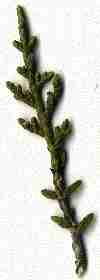
Foliage [C.J. Earle].
Common Names
Tecate or Forbes cypress (2).Taxonomic notes
Syn: C. forbesii Jepson 1922 (2).Description
Trees to 10 m tall, often shrubby; crown globose, sparse. Bark of trunks exfoliating, leaving a clear brown or rich cherry-red smooth surface, sometimes only partially peeling away, and persisting as grayish shaggy scales with curling edges. Branchlets decussate, mostly 1-1.5 mm diam. Leaves about 1.2 mm long, acute but rather blunt-tipped, rounded or ridged on the back, light rich (never glaucous) green, often with slightly darkened, inconspicuous, embedded, abaxial gland that does not produce drop of resin except on the larger leaves of vigorous young shoots. Pollen cones abundant, 3-4 × 2 mm; pollen sacs 3-5, slightly 4-sided, of 8 to 14 scales. Seed cones globose, mostly (2)2.5-3.5 cm, brown, not glaucous; scales mostly 4 - 5 pairs, smooth, umbos flat or to 5 mm, dull gray to brown. Seeds mostly 5-6 mm, plump, rich dark brown, not glaucous (2, 4).Range
USA: California; Mexico: Baja California Norte. In California, occurs in the Santa Ana Mountains (Orange County); Guatay Mountain and Otay Mountain (San Diego County); and Mount Tecate on the U.S.-Mexican boundary. In Baja California Norte, found on Mt. Tecate and in El Cañon de Pinitos (110 km S of Ensenada). Habitat chaparral, at 450-1000 m. Of conservation concern (2, 4).Big Tree
Height 14 m, dbh 71 cm, crown spread 12 m; in Guatay, CA (3).Oldest
One of the largest trees I have seen had recently lost one of its two major stems in a severe winter storm. The exposed break revealed about 100 growth rings, indicating that this tree, among the largest in the stand, was not more than 120 years old. Since the species is fire-dependent and occurs in chaparral, older individuals are not likely to be found unless a tree by chance establishes on a fireproof site, e.g. on a cliff or rocky barren.Dendrochronology
Ethnobotany
Observations
Little (5) says that "Perhaps the most accessible grove of Tecate cypress is ... on the Cleveland National Forest, Sec. 21, T. 15 S., R. 4 E., altitude about 4,000 feet [1220 m].". To reach the site, follow Interstate 8 about 40 miles [64 km] E from San Diego and take the CA 79 exit N (towards Cuyamaca Rancho State Park, home of C. arizonica var. stephensonii) for about 4 km. Here, turn E onto Old Highway 80 and go about 3 km to reach the hamlet of Guatay, where a cafe and trailer park can be found. The stand is visible from here on the mountainside to the SW. It is most easily reached by returning down the highway about 500 m, crossing the creek in the valley bottom (forested with large oaks and Coulter pines, Pinus coulteri), and walking W along an old roadbed for not more than 5 minutes until the trees are visible directly uphill. Here a trail can be found winding up through chaparral and into the stand, which is patchy and extends nearly to the mountaintop. When I visited the site, in March 1998, I found trees up to 10 m tall and 85 cm diameter.Remarks
Type specimen collected 30-Dec-1907 by Charles N. Forbes in Cedar Canyon between El Nido and Dulzura, on the N side of Otay Mt., in San Diego County, CA. It was previously (5-Jul-1894) collected at the same locality by Edgar A. Mearns (5).Curiously, Pinus radiata has a similar distribution pattern. The bulk of its native range is local on the coast of central California, while a disjunct population occurs on Guadalupe Island (5).
Like other California cypresses, this species is serotinous, the cones opening and shedding seed only after a fire or occasionally, on extremely hot days. It is unusual in that many of the cones are borne directly on the trunk or major branchlets. These cones are retained and are often engulfed by stem growth. This situation seems to be directly analogous to the of the closed-cone pines of California, all of which are serotinous and thus highly fire-dependent. The serotinous pines may open some cones on exceptionally hot days and perhaps that is the case in this species as well, which would explain how it can sustain regeneration despite an ongoing regime of fire suppression. Certainly the trees I saw on Guatay Mountain had a mixture of opened and closed cones.
Citations
(1) Silba 1986.(2) Peattie 1950.
(3) American Forests 1996.
(4) James E. Eckenwalder at the Flora of North America web site.
(5) Little 1970.
[Cupressus] [Cupressaceae] [home]
This page is from the Gymnosperm Database
URL: http://www.geocities.com/~earlecj/cu/cup/forbesii.htm
Edited by Christopher J. Earle
E-mail:earlecj@earthlink.com
Last modified on 27-Feb-1999